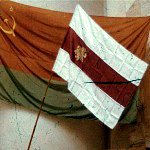 image
by Željko Heimer, 24 April 1996
image
by Željko Heimer, 24 April 1996
Last modified: 2015-12-17 by rob raeside
Keywords: belarus | ussr | europe | commonwealth of independent states | national ornamentation | referendum | belorussia | byelorussia |
Links: FOTW homepage |
search |
disclaimer and copyright |
write us |
mirrors
 image
by Željko Heimer, 24 April 1996
image
by Željko Heimer, 24 April 1996
See also:
Editorial Remark: It must be noted that all the opinions are the authors opinions and not of FOTW. Our site is non-political and concentrates only on vexillological issues.
After the decomposition of USSR, Belarus adopted a white-red-white flag but the referendum on 14-May-1995 came back to the Soviet-like flag.
The first national state of the Belorussians was proclaimed on 09.03.1918 as
Belorussian People's Republic, and its independence (from Russia) was proclaimed
on 25.03.1918. It was liquidated on 05.01.1919. Its flag was white-red-white
horizontal stripes. Here is some photo evidence.
Valentin Poposki, 21 March 2012
The white in the flag is an allusion to the name of the
country - 'White Russia' (or 'White Ruthenia'). The red is for
national freedom and the rising sun. White and red frequently
appear in the national costumes of White Ruthenians.
Stuart Notholt
I found some news from Belarus:
from NEWSLINE Vol. 1, No. 165, Part II, 21 November 1997 (<www.rferl.org>):
"LUKASHENKA OPPONENTS STAGE FLAG PROTEST. On the first
anniversary of the vote that gave President Alyaksandr Lukashenka
sweeping powers, Belarusians opposed to his rule displayed the
now outlawed red-and-white national flag, RFE/RL's Belarusian
service reported on 20 November. Some flags were so large that
the authorities had to use heavy-duty equipment to remove them.
No single group has taken responsibility for the latest
protest."
Christian Berghnel, 6 December 1997
Is the W-R-W actually outlawed in Belarus then? I mean rather
than simply no longer being used.
Roy Stilling, 6 December 1997
www.belarusguide.com
Dov Gutterman, 2 July 1999
from http://www.savva-la-belle.com/belarus/symbols.shtml (no longer
available):
The origins of the traditional white - red - white Belarusian
flag are lost in the mists of ancient history. It is possible
that the banner was designed simply to distinguish Belyj Rus
(White Russian) forces from those of the Princes of Kiev and
Muscovy by placing the red favored by the Rus on a background of
white.
But the traditional story is that when the united armies of
Poland and the Grand Duchy of Litva and Rus defeated the Germans
of the Teutonic Order at the great Battle of the Grunewald in
1410, a wounded Belarusian knight tore off his blood-streaked
bandage and waved it aloft as a victory banner. That banner has
been flown ever since, so the story goes, as a sign that Belarus
will always prevail -- no matter how badly wounded it may be!
Jarig Bakker, 9 July 1999
The old Bielorussian colours have always been the white and
red and in fact the flag of the first independent government of a
"Byelorussian People's Republic" (in exile in Vilnius
from 1919-1925) was a white flag with a red horizontal band of
red, the central red stripe being bordered by a thin black
stripe.
Emil Dreyer, 30 September 1999
The German weekly news magazine "Der Spiegel"
sometimes contains photos with flags. At issue 7 of 2001 (p. 166)
you can the former prime minister of Belarus, Chigir, with some
tiny desktop flags, one of them white-red-white
with some device in the centre. See
www.smev.de.
Marcus Schmoger, 28 February 2001
In to today's New York Times, there is an article about the
recent election in Belarus with a photo of dissidents flying the
W-R-W flag.
Al Kirsch, 11 September 2001
The white-red-white flag was official during the National
Republic, which lasted only nine months (March-December 1918),
before the occupation of the country by the Soviets. Its official
use was restored in 1991, but abolished by Alyaksandr Lukashenka
in 1995. The great historian and patriot Vaclau Lastouski,
president of the Democratic Republic (1919-1923), afterwards
murdered by Stalin, proposed that the name of the country should
be changed to "Kryvija", in order to distinguish
Belarus as much as possible from Russia (the "Kryvitci"
or Kryvians were a Slavic tribe in the Middle Ages). To tell the
truth, the name "Belarus" is much older than
"Rossija".
Name withheld by request, 18 April 2002
"The rise and fall of Belarusian nationalism" (Pittsburgh: Univ. of
Pittsburgh Press, 2015), pp.88-89, gives some more information about its
origins, with a bibliographical reference to a book in Polish. The author says
it was designed in 1917 by Klaudiusz Duz-Duszewksi (1891-1959). Several
explanations were given of its significance. The designer's son claimed his
father "had seen the design on ribbons carried by Belarusian students in Saint
Petersburg already before 1915". Belarusian Free Corps members in Estonia and
Latvia claimed the colours stood for sweat, blood and tears. The prominent
nationalist politician Vatslau Lastouski said "It reminds us of our [white]
peasants' coats with a red belt."
Kenneth Fraser, 10 November 2015
 image located by Ben Cahoon,
22 May 2012
image located by Ben Cahoon,
22 May 2012
I do not recognize the version of the Belarus flag in the photo. It looks
like the previous flag with a small image of gold knight on a horse, similar to
images of Vytautas on Lithuanian flags. Here is the story below that was sent to
me about a Belarus soccer fan being banned from using the red/white flag at a
game in Poland.
http://collaboration.org.ua/en/polish-prosecutors-banned-belarusian-national-flag/
"Belarusian fans have no right to support national team under a national
white-red-white flag on international sporting events in Poland. This follows
from the request of the Polish prosecutors on the application of an offense
against a group of Belarusian basketball fans at the match Belarus-Lithuania in
Bydgoszcz. Request to the Polish prosecutor's office was sent by Belarusian fan
Ihar Shchekarevich. According to Polish prosecutor, white-red-white flag "is not
mandatory national flag of Belarus". Therefore, the Belarusian fans were not
allowed to use it at the match. Refusal to leave the stadium Polish prosecutors
described as a resistance " from Shchekarevich. Therefore, the security guards
did not break the law when they used physical force against Shchekarevich.
Belarusian himself is not surprised by this answer of prosecutors.
Shchekarevich: "Yes, such a response is not surprising. I got it from the Polish
prosecutor's office. They are, in my opinion, deliberately transmit bank
information of Ales Belyatsky to Belarusian authority. This is the same
prosecutor's office, which has being persecuting a political refugee Andrew
Zhukavets for 12 years. I think the Polish prosecutor's office has a lot of
"Belarusian skeletons" in the locker. In the near future I will consult with the
leadership of the Center "Collaboration without borders" and decide which steps
we take in this matter further".
Let us remind that the incident occurred on
June 25, 2011 during the match of women's European basketball championship in
Bydgoszcz. Belarus played against Lithuania. Guards of the stadium, which hosted
the game, prevented a group of Belarusian fans to deploy white-red-white flags,
and then rudely removed Belarusians from the stadium."
from:
http://collaboration.org.ua/en/polish-prosecutors-are-forced-to-punish-guilty-of-insulting-the-belarusian-flag-photo
Ben Cahoon, 22 May 2012